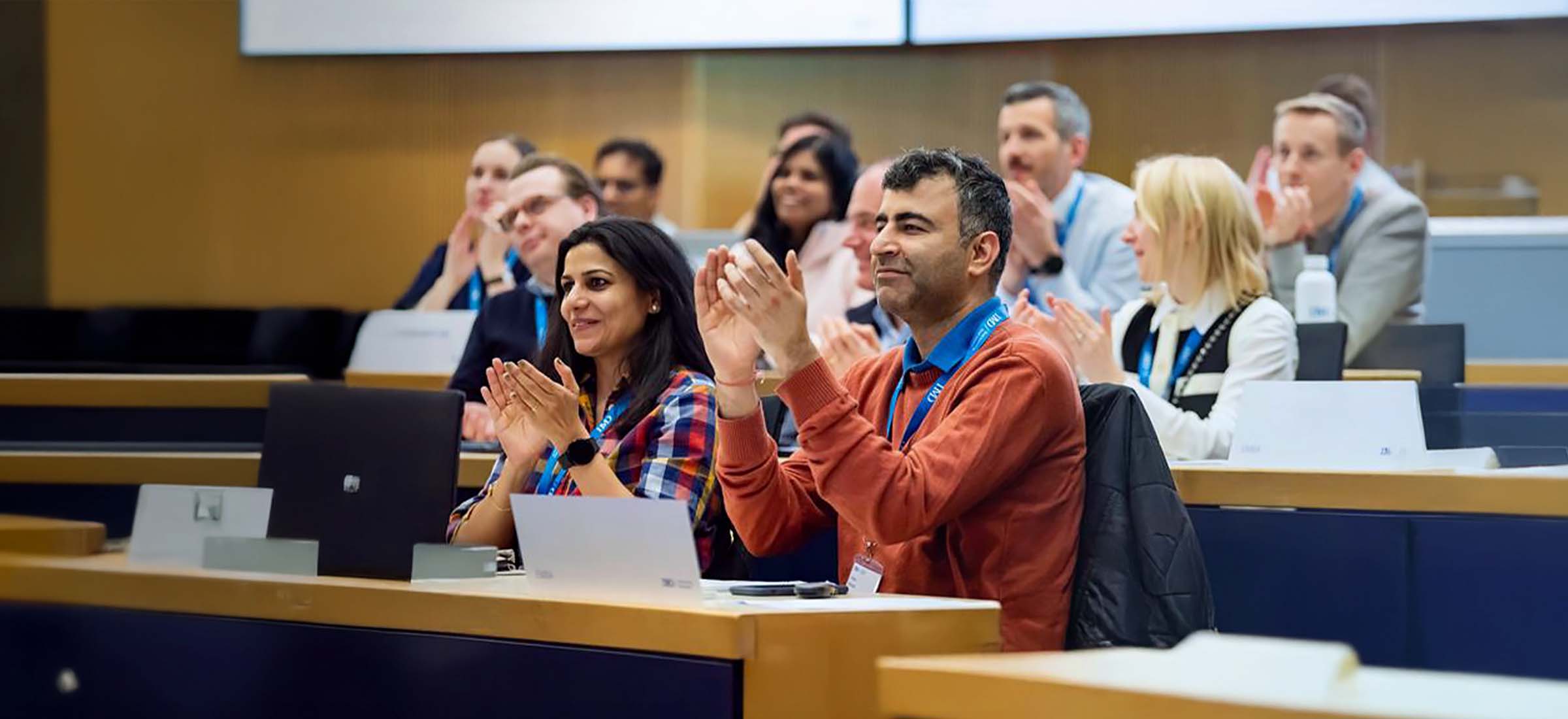Markets shift, technologies evolve, and disruption is constant. In this context, the ability to approach complex problems with clarity and adaptability has become a core leadership advantage. While traditional leadership competencies such as vision, communication, and execution remain essential, it is problem-solving that enables leaders to navigate ambiguity, align teams, and deliver strategic outcomes.
Problem-solving in leadership is not reactive—it is proactive. It requires understanding context, framing issues clearly, mobilizing collaboration, and adapting in real time. And although some people may appear naturally skilled at this, the reality is that problem-solving can be learned, practiced, and refined.
This article explores what problem-solving means in today’s business context, why it matters, and the 8 core skills leaders must develop to solve challenges more effectively and sustainably.
- What is problem-solving in business?
- What are problem-solving skills?
- Why is problem-solving important for leaders?
- 8 Core problem-solving skills you should master
- How approaches to complex challenges have evolved
What is problem-solving in business?
Problem-solving is the structured, intentional process of turning ambiguity into clarity and action. It involves diagnosing what’s really going on, surfacing insights from across the organization, and implementing solutions that align with strategic goals—not just quick fixes.
In the business world, challenges come in many forms—delayed projects, misaligned teams, shifting markets. What distinguishes high-performing organizations is not whether they encounter problems, but how they address them.
Done well, problem-solving connects the dots between immediate action and long-term direction. It helps leaders stay responsive without losing sight of the bigger picture.
Problem-Solving vs. Decision-Making: What’s the difference?
While closely related, problem-solving and decision-making are not the same—and understanding the difference helps clarify where your skills need to grow.
Problem-Solving | Decision-Making |
Involves identifying the issue and possible paths | Focuses on selecting the best course of action |
Requires exploration, analysis, reframing | Requires evaluation, prioritization, commitment |
Embraces ambiguity and multiple possible outcomes | Aims to resolve ambiguity and move forward |
Often iterative and collaborative | Often individual or with input from select voices |
Strengthening one without the other can lead to lopsided leadership—either stuck in analysis or too quick to act.
Effective leaders move fluidly between both. They diagnose problems thoroughly and then make decisions that are timely, strategic, and informed by the right inputs.
What are problem-solving skills?
Solving problems effectively isn’t about having all the answers—it’s about having the tools to ask the right questions, manage complexity, and navigate uncertainty with composure.
Problem-solving skills refer to a broad set of capabilities that combine analytical thinking, emotional intelligence, and practical execution. These include:
- Cognitive skills – such as logic, reasoning, and systems thinking
- Interpersonal skills – including collaboration, empathy, and facilitation
- Creative thinking – like brainstorming, reframing, and lateral exploration
- Execution skills – such as research, prioritization, and implementation
Great problem-solvers don’t rely on one approach—they apply the right combination depending on the challenge. And they build these skills over time, through deliberate practice and reflection.
Why is problem-solving important for leaders?
Leadership today is inseparable from complexity. Whether managing transformation, navigating disruption, or driving growth, the challenges leaders face are rarely linear—or predictable.
These situations demand more than instinct or authority. They require leaders who can interpret shifting conditions, mobilize teams, and move forward even when information is incomplete.
Here’s how effective problem-solving strengthens leadership:
Sound decisions amid ambiguity
In uncertain contexts, waiting for perfect information isn’t an option. Problem-solving helps leaders prioritize, act with confidence, and manage risk.
When a financial services firm faced new regulations, reframing the challenge as a process upgrade—not just a compliance issue—led to faster adoption and long-term savings.
Empowered, aligned teams
Strong problem-solvers model clarity and autonomy. In one tech company, training frontline managers in decision-making frameworks improved response time and boosted innovation—without added oversight.
Innovation with focus
Great ideas mean little without relevance. A retail brand solved declining sales not with a flashy campaign, but by fixing a pain point in the checkout experience—improving conversion while staying true to its strategy.
Learning from failure
Not all solutions work. But when leaders treat failure as data, they adapt faster. A B2B startup salvaged a failed launch by identifying messaging misalignment and adjusting communications—reversing the trend within weeks.
Ultimately, problem-solving is a leadership multiplier. It’s not just about finding the right answer—it’s about shaping a culture where people know how to ask the right questions.

8 Core problem-solving skills you should master
Each of the following skills represents a critical component of effective problem-solving. When developed together, they help leaders move beyond short-term fixes and build solutions that last.
1. Problem Framing
Leaders don’t just answer questions—they shape them. Framing a problem correctly is often what distinguishes a tactical response from a strategic one.
By asking:
- What are we really trying to solve?
- What outcomes are we optimizing for?
- Are we looking at symptoms or root causes?
You can avoid costly misalignment and design solutions that directly address the true issue.
Framing is not about simplification—it’s about definition.
2. Empathy
Empathy allows leaders to understand problems not just from their perspective, but from those who experience them firsthand—be it customers, employees, or partners.
This leads to solutions that are more relevant, more inclusive, and more likely to be adopted. Empathy doesn’t replace analysis—it informs it with human insight.
3. Breaking Fixedness
Organizations tend to solve new problems with old solutions. Cognitive fixedness is the habit of defaulting to what’s familiar—even when the context has changed.
Breaking this pattern means:
- Asking “what if we tried the opposite?”
- Exploring how unrelated industries solve similar issues
- Reframing constraints as opportunities
This doesn’t require radical creativity, it requires openness and disciplined curiosity.
4. Psychological Safety
Even the best problem-solving frameworks fail if people are afraid to speak up. Psychological safety—the belief that it’s safe to take interpersonal risks—enables teams to surface concerns, challenge thinking, and contribute ideas.
Leaders foster this environment not by always agreeing, but by being intentional: they normalize learning from failure, actively reward critical feedback, and ask thoughtful questions before jumping to conclusions.
Safety is the foundation of agility and innovation.
5. Creativity
Creativity in problem-solving isn’t about being artistic—it’s about seeing options where others see limitations. It means connecting dots across silos, asking unexpected questions, and generating alternatives quickly.
Creative leaders facilitate idea generation, avoid early evaluation, and give their teams permission to explore before converging.
6. Research Skills
Data-driven decision-making starts with the ability to gather the right data—and interpret it in context.
Effective research includes:
- Quantitative analysis (what is happening?)
- Qualitative exploration (why is it happening?)
- Hypothesis testing (what could improve it?)
Research validates intuition and sharpens judgment.
7. Teamwork
Collaborative problem-solvers bring teams together without losing momentum. They know how to translate across domains, facilitate alignment without falling into consensus fatigue, and keep groups focused on outcomes rather than personal opinions.
This ability to bridge perspectives and drive shared action is especially valuable when navigating cross-functional challenges or high-stakes decisions.
8. Adaptability
No matter how well a plan is crafted, real-world execution reveals blind spots. Leaders must always be willing to adapt—without losing strategic intent.
Adaptability requires:
- Early feedback loops
- Willingness to pivot
- Confidence to iterate in public
It’s not a backup plan. It’s a leadership strategy.
How to build these skills?
Building these skills requires intentional practice, reflection, and feedback. The table below offers examples of how each skill can be strengthened through structured actions:
SKILL | HOW TO BUILD IT | EXAMPLE TECHNIQUES |
Problem Framing | Challenge assumptions and clarify desired outcomes | Root cause analysis, "5 Whys" |
Empathy | Engage stakeholders in discovery | Interviews, journey mapping |
Breaking Fixedness | Rethink constraints and explore alternatives | Reverse thinking, analogy mapping |
Psychological Safety | Create environments that encourage risk-taking | Retrospectives, inclusive facilitation |
Creativity | Open space for divergent thinking | Brainstorming, SCAMPER, cross-industry comparisons |
Research | Validate solutions with data | Surveys, experiments, qualitative insight |
Teamwork | Align perspectives and co-create solutions | Design sprints, co-working sessions |
Adaptability | Test, pivot, and iterate based on feedback | Agile cycles, pilot projects |
Problem-solving can be developed intentionally through structured thinking and deliberate practice.
If you’re looking for a practical starting point, explore our IbyIMD article on the 3 steps to critical problem solving, which breaks down the process into clear, actionable phases.
How to highlight these skills on a resume
Recruiters scan hundreds of resumes, and vague references to “problem-solving” often get overlooked. Instead of listing it as a soft skill, demonstrate it through concrete actions and measurable impact.
The key is to let the achievement tell the story. Use dynamic verbs, clarify your role in the resolution, and—whenever possible—quantify the results.
Rather than writing: “Strong problem-solving skills” or “Excellent critical thinker”
Show it like this:
- “Redesigned cross-team workflow to eliminate redundancies, reducing project delays by 28%.
- “Identified and resolved market-entry barriers in LATAM expansion strategy, accelerating launch by two months”
Each bullet should answer:
- What was the challenge?
- What did you do?
- What changed as a result?
Use strong, active verbs such as: Diagnosed, Resolved, Reframed, Implemented, Simplified, Facilitated, Transformed.
If you’re applying for leadership or strategic roles, highlight how your problem-solving approach aligned with broader company goals or influenced team behavior.
How approaches to complex challenges have evolved
The nature of business problems has changed dramatically. So have the ways we solve them.
Today’s challenges—remote collaboration, cybersecurity threats, data overload, shifting customer behavior—demand more than linear thinking. They require adaptive systems, real-time feedback, and collaborative innovation.
Key shifts in how we solve problems include:
- From intuition to insight: Leaders increasingly rely on data-driven diagnostics instead of gut instinct alone.
- From command to co-creation: Digital tools enable cross-functional collaboration in ways that were unthinkable a decade ago.
- From planning to iteration: Agile, test-and-learn approaches allow teams to adjust faster, lowering the cost of failure.
- From closed to open systems: Many companies now involve users, partners, or external communities in solving strategic problems.
As problem-solving adapts to digital complexity, professionals need new frameworks and habits of thinking. IMD’s Complex Problem Solving online program offers tools and guided practice to navigate today’s dynamic environments with clarity and purpose.
Solving smarter in a complex world
As we’ve explored throughout this article, effective problem-solving is far more than a single skill. It’s a strategic mindset—one that involves framing challenges clearly, fostering collaboration, navigating ambiguity, and learning from failure.
When done well, it strengthens decision-making, empowers teams, and drives meaningful, long-term impact.
At IMD, we help professionals and executives cultivate these capabilities through challenge-based learning, peer collaboration, and faculty expertise.
If you’re ready to strengthen your strategic impact through problem-solving, explore our Strategic Thinking Program.
Delivered 100% online over eight weeks, the program equips you with proven frameworks to tackle complex business challenges, sharpen your analytical and decision-making skills, and apply strategic thinking in real-world contexts. You’ll learn alongside a global cohort of peers, guided by IMD faculty with deep industry experience.
Get the latest strategic content in your inbox 💌
